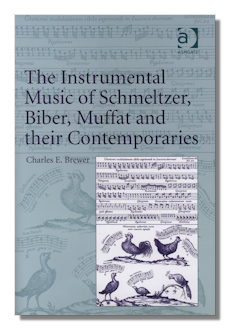
The Internet's Premier Classical Music Source
Related Links
-
Introduction
Acoustics
Ballet
Biographies
Chamber Music
Composers & Composition
Conducting
Criticism & Commentary
Discographies & CD Guides
Fiction
History
Humor
Illustrations & Photos
Instrumental
Lieder
Music Appreciation
Music Education
Music Industry
Music and the Mind
Opera
Orchestration
Reference Works
Scores
Thematic Indices
Theory & Analysis
Vocal Technique
Search Amazon
Recommended Links
Site News
 Book Review
Book Review
The Instrumental Music of Schmeltzer, Biber, Muffat and Their Contemporaries

Charles E. Brewer
Ashgate, 2011 xxvi + 412 pp
ISBN-10: 1859283967
ISBN-13: 978-1859283967
Rather than assign the label of "school" to the composers, Johann Heinrich Schmeltzer (c.1620/23-1680), Heinrich Ignaz Franz von Biber (1644-1704), Georg Muffat (1653-1704) and their Bohemian and Austrian contemporaries, Charles Brewer, Associate Professor of Musicology at The College of Music of the Florida State University, has chosen – rightly – to emphasize the historial and cultural common ground in which these musicians of the Early Baroque lived and worked.
Without for a second drawing anything from the overall achievements – and especially the startling originality – of Schmeltzer (the, admittedly, more common "Schmelzer" is actually a Latinized form, to which the composer, Brewer believes, preferred – it's the spelling which the latter adopts consistently in this book), Biber and Muffat, Brewer emphasizes the inevitable impact on these composers of the way music was made in the seventeenth century in their middle-European region, its institutions and the expectations of audiences, participators and worshipers.
Indeed, it's perhaps striking to us that the overlap between secular and sacred was as great as it was: it was not unusual for the church to see its function as bringing joy, and the court offering edification. Brewer basis his exhaustive, scholarly and highly readable and illuminating analyses of the work of these three composers and their contemporaries on stylistic considerations… the Stylus Phantasticus and Stylus Hyporchematicus in particular. Indeed, the rise and demise of the former co-incided closely with their lives. It's almost inconceivable that, having worked your way through the nearly 400 substantive pages of The Instrumental Music of Schmeltzer, Biber, Muffat and Their Contemporaries, you wouldn't have a firm and fluid grasp of the origins, variety, greatness and relative imports of all the music discussed.
By "discussed" must be meant several complementary things: the instrumental works of Schmeltzer, Biber and Muffat as well as such contemporaries as Kapsberger, Kircher, Prinner, Rittler, Poglietti, Clamer are in turn introduced in context and with a sense of place in a notional overall catalog (first publications) and chronology where appropriate; analysed from a musical point of view and also in wider cultural context with extracts from scores; cross-referenced to and with a whole host of relevant sources… dictionaries, other manuscripts, works of art, literature, phonetics, treatises ancient and modern, allusions to contemporary and modern performance traditions and so on.
This is all very factual, of course; but in the end such discourse really is in the direct service of a greater understanding and appreciation of the music. Although Brewer's knowledge is encyclopedic, this book is not an encyclopedia, nor yet a mere guide. It's a study. And a very accessible study. The "Notes to the Reader" [pp xiii-xxvi], for example, explain needed frames of reference… the pitch used, how concepts of key (and modality) are used, manuscripts and editions – as well as abbreviations. The reader is very well looked after in what can be a somewhat daunting set of conventions, particularly to the non-specialist.
Again, even with such admirably professional structure, it's the beauty, uniqueness and pleasure given by the music of these three central composers that justifies the rather high price of almost $120. Make no mistake, Brewer has succeeded admirably and his scholarship, tone and written manner not only bring the music alive and commend its virtues to us, but genuinely shed light on what can be an otherwise somewhat overlooked area of Baroque music.
Brewer draws heavily on still unpublished sources from the Moravian archives in Kromĕříž Indeed, many of these works are also still unpublished as such, although for some there are (some very creditable) recordings. This is a book that could be dipped into as you acquire them. It could offer you guidance on which are the most significant works (there is no discography). And it's a book which – if read sequentially – will afford you a most thorough and brilliant understanding of the world of these remarkable composers, their works and lives.
Technically, the book is exemplary. With an extensive index, unannotated bibliography, three appendices, many tables, a handful of appropriate and highly illustrative (the tarantella dancers [on page 4] graphic, for instance, says a lot) illustrations as well as a list of the several hundred musical examples, the footnoting, layout, editorial standard and general authoritative feel of The Instrumental Music of Schmeltzer, Biber, Muffat and Their Contemporaries make this the standard, even definitive, work of its kind on the subject. It should be well received and can be warmly recommended to specialists and lovers of music of the period, genre and region in general.
Copyright © 2011 by Mark Sealey.


















